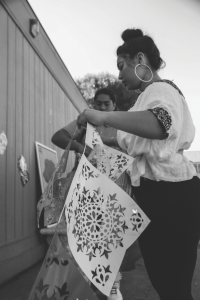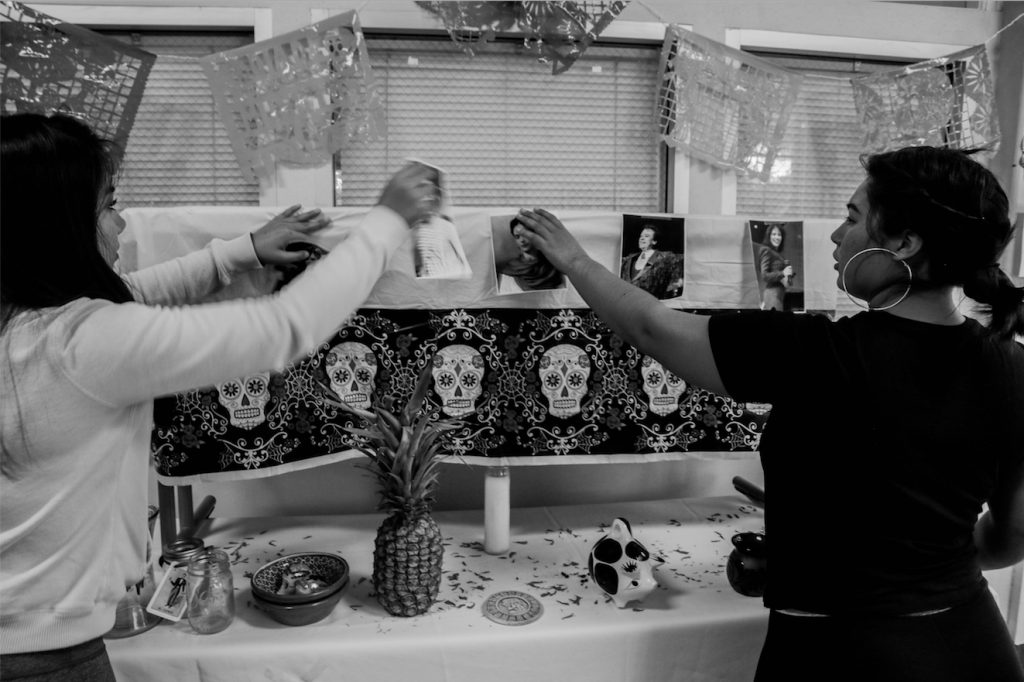Blazing orange and sky blue paper decorations flood the quad as students laugh and mingle while winning sugar skulls and traditional sweet bread, or pan de muerto. This is LatinX Club’s celebration for Día de los Muertos — also known as Day of the Dead — a holiday of loved ones who have passed that originated in Mexico as a combination of Aztec and Spanish-Catholic traditions.
LatinX Club, formerly known as Latinos Unidos, is a group that promotes understanding and celebration of Hispanic culture through campus events such as the painting of last year’s mural on the outside wall of the Student Center.
Last year, the club encountered issues with the administration while planning their flagship Día de los Muertos event, but this year they persisted. As one of Paly’s most active cultural clubs, LatinX is always looking for new opportunities to inform students.
Tradition in practice

During Día de los Muertos, families set up ofrendas, or altars, where they leave offerings and
gifts of food, drinks and other items to pay tribute to ancestors who have departed. The center of the altar is usually comprised of an array of family photographs of dead loved ones who are being honored.
On Nov. 2, LatinX Club’s altar was on display in the Tower Building, adorned with flowers and candles to guide souls toward the altar.
Freshman Maggie Guevara, who joined the club this year, says she is glad she has a place to learn about and appreciate her culture.
“My parents are both Hispanic and they’re always trying to show us new things about how they grew up, so I wanted to learn through this club,” Guevara says. “Because I was born here in America, I don’t know many of their customs.”
Altering the altar
If you saw LatinX Club’s altar this year, you would have noticed that there weren’t the traditional photographs of family friends or relatives on display. Instead, only those of famous Latinx celebrities graced the memorial. According to President Jennyfer Avila-Zavala, last year the Wellness Center staff and administrators took issue with the club performing this practice at school.
“Last year, the Wellness Center was talking about how that [putting up pictures of dead loved ones] would bring triggers to people at Paly,” Avila-Zavala says. “So we had a whole meeting with all the club members and the Wellness Center in which they told us that we could not put memories of people that had passed away.”
Avila-Zavala also says the Wellness Center said that other students could get upset that their loved ones weren’t up on the altar, thus making the event too exclusive.
Despite the club’s protests, the Wellness Center decided that LatinX could only include pictures of famous people. LatinX Club members say that this misses the point of the holiday.
“[Día de los Muertos] is about our loved ones, not about ‘celebs,’ like César Chávez or Selena [Quintanilla-Pérez], which is what we had to do,” Avila-Zavala says.
Cultural exchange
Since not all members have strong traditions for Día de los Muertos in their households, LatinX took a field trip to San Jose State University on Oct. 18 in order to get inspiration for their own altar from some campus displays and learn more about the cultural history of the centuries old celebration.
“I think they got a lot of ideas and learned a little bit more because they knew what an altar was, but they didn’t know what they could incorporate,” says College and Career Center and club adviser Crystal Laguna. “So the altar that we have up now, some of the things [the club used], we actually got from those [San Jose State] altars to use as inspiration.”
For example, the white tablecloth used in LatinX’s altar took direct inspiration from San Jose State’s counterpart.
“The club learned that the white tablecloth is very important because it symbolizes purity,” Avila-Zavala says. “There were also smaller skulls that [San Jose State altars] had that we got from San Jose because we didn’t really have one.”
The club serves to educate the student body as much as it does its own members. Last year, the club members chose not to do a school-wide Cinco de Mayo event because they did not want to perpetuate the popular misconception that the holiday commemorates Mexican Independence Day — it actually celebrates a Mexican victory over the French army in 1862. Instead, they held a private club celebration.
“As they’re learning a little bit about their own culture, they’re able to share it with their friends who may not be part of the club, and hopefully we’ll persuade them to be part of it,” Laguna says.
According to club materials, Día de los Muertos is a time when the barriers between the spirit world and the living world break down, allowing the dead and the living to celebrate together with their family and their loved ones.
Similarly, to Laguna, LatinX Club serves to break down barriers, those between cultures. There, students — no matter their background — can learn about and celebrate Latinx culture and traditions together.
“I always make sure to tell students when they reach out to me they always say ‘Can I join even if I’m not Latino?’” Laguna says. “I say that it is for anybody and everybody who wants to help support us.”



